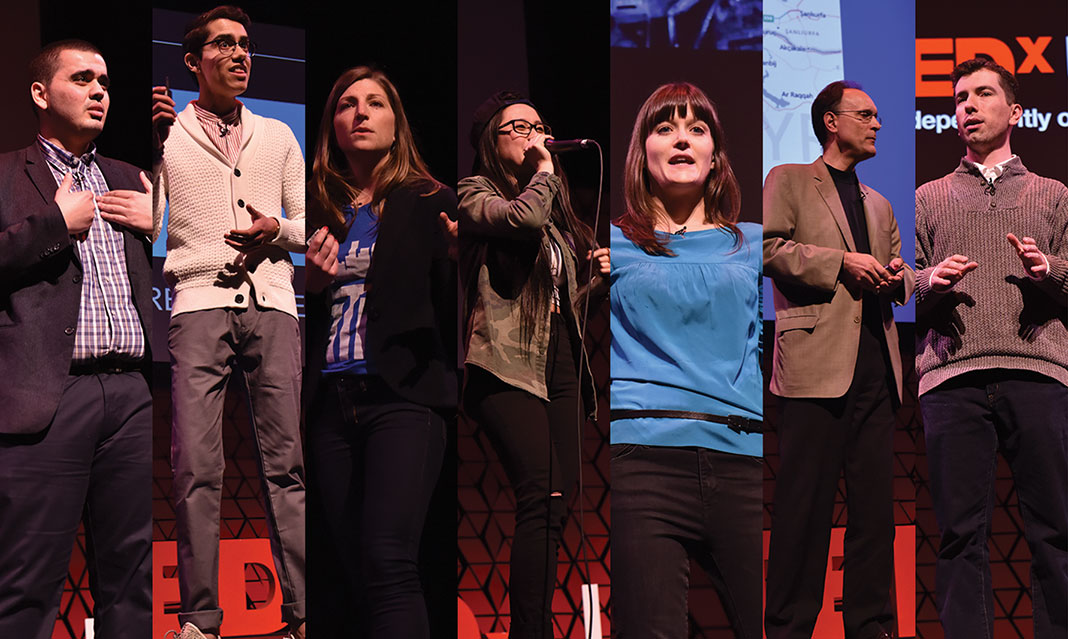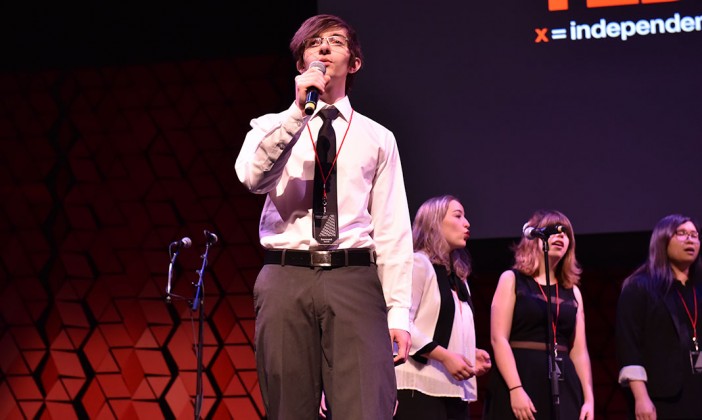Last Saturday, the halls of the St. Lawrence Centre in Toronto buzzed with anticipation as attendees filed into the theatre, where the fourth annual TEDxUofT was set to commence. Volunteers guided student delegates to their seats, excited to hear what some of the top minds in their respective fields would have to offer to those just beginning their forays into changing the world.
The event kicked off with an a cappella performance, courtesy of U of T Faculty of Music’s Surround Sound, who began by digging deep into the audience’s nostalgia with a performance of Britney Spear’s “Toxic” blended with Muse’s “Supermassive Black Hole”. As the ensemble segued into a cover of Drake’s “Hotline Bling”, the unstated but essential element of TEDx emerged: that an understanding of what is and has been is essential in the anticipation of what is to come.
Alan Cross, Toronto-based radio personality and event MC, proceeded to take the stage, and with a brief personal introduction, moved into a reflection on the importance of ideas and stories. “Whoever dies with the most stories wins,” he concluded.
Jooyoung Lee, a U of T assistant sociology professor, began the succession of speakers with an appeal for social compassion, and in spite of the event’s imposing theme of living on the edge, underscored by the hashtag “#EDGE2016”, an unstated, underlying theme of the importance of empathy began to weave its way into the conference. Following statistics on the difficulties of overcoming violence within black communities, Lee laid out a moving recollection of his friendship with Flawless, a hip hop artist whose story Lee employed to emphasize the importance of caring for victims of gun violence. Lee concluded that above all else, an attentive ear and compassion are the best tools to overcome challenges of violence in racialized communities.
In keeping with the emphasis on empathy, a moving talk by Lisa Boivin on indigenous resilience through art followed. Boivin ardently recounted times of personal healing and her relationship with her daughter among sources of inspiration for the reclamation of indigenous identity.
Immediately following the break, professional dancers–turned–U of T students Patrick Lavoie and Chris Stalzer took the stage.
Stalzer danced with the National Ballet of Canada in 2007 and performed as second soloist in 2012. Lavoie danced as first soloist for 12 years, ultimately retiring from the National Ballet of Canada in 2015.
Both individuals have spent their entire lives training their bodies and minds to be meticulous pieces of art.
To have their narratives come crashing down recently because of aging is a cruel fact to swallow, but these two talented men have not ended their journeys yet. They are currently reinventing themselves, living in a world that has obstacles outside of ballet, and they couldn’t be more excited and frightened at the same time.
Stalzer and Lavoie have taken up a university education at the University of Toronto. While there is an oddity about coming to class among a whole class of 18-year-olds, the two accept their lives as unique journeys and something with a lesson learned at the end.

“Here we are now and it’s been a whirlwind of a year; in a way, it feels like we’re taking two steps backwards to go one step forward,” said Stalzer. “This isn’t a success story, it’s a story about transition and we’re constantly trying to adapt to what’s next.”
“Its been therapy sometimes—the stage is a very special place, and there’s nothing quite like it. We had the chance to fulfill a dream and now our new journey isn’t perfect, but it gives us an opportunity to explore something new,” said Lavoie.
“Art isn’t exclusive, art is everywhere, and I think that wherever we end up, our artistic past will be a part of that,” he added.
Following a talk on the importance of home cooking by Bonnie Stern and a heartfelt performance by singer and Montreal native Peter Katz, Nazar Polodian took the stage to educate on providing work opportunities for refugees, infusing the event yet again with the pervasive emphasis on social compassion. Polodian, himself a Syrian refugee, cited his personal experiences as an example of what can be accomplished when Canadian communities reach out to refugees with open arms.
Next up was Swish Goswami, who, bounding onto the stage in a pair of Yeezys, presented an invigorating case for social entrepreneurship. Goswami, an 18-year-old university student, carried a rock star appeal and almost immediately had the entire theatre’s attention. The first to explicitly state the word “empathy” as the key feature of social engagement, Goswami cemented the event as a socially conscious call to arms. Recounting his challenges as a young man, including a speech impediment and immigrant status, Goswami endeavoured to make it clear that no challenge was too insurmountable for those wanting to make a positive dent in their community.
The third quarter concluded with a summation of current efforts to combat climate change by Sara Hughes, assistant professor of political science at U of T.
Beginning with U of T student Jane Souralayack’s beatbox performance, the final quarter proceeded with an analysis of the current progress of drone technology by Angela Scheoling as well as a reflection on the importance of archaeological documentation in the 21st century by Timothy Harrison.
Finally, delegates heard from a man who in just a single decade could become known as “The Martian”. Ben Criger, a Ph.D. candidate at the University of Waterloo, is one of 100 candidates being suggested for the final 24 colonists headed to Mars in 2026.
Criger said that the first thing NASA asked him when he applied to go to Mars was whether he had a sense of humour, which he said he does.
“The question becomes why I would want to go. When I was a kid, my mom and dad used to have a saying that they would use whenever we were unable to get something done as a society or species. They’d point to whatever it was and say [that] we can put a man on the moon, but we can’t get our species to do this on Earth,” he said.
“The estimate to head to Mars is about $2 billion a year. We already spend about $10 billion a year on space exploration so it isn’t crazy to say we could spend $2 billion sending people to Mars. If you look at the way money is spent on Earth, it’s embarrassing; for example, over the past 90 days, Star Wars VII sold over $2 billion dollars’ worth in tickets. The question is, are we willing to spend money in real space rather than [in science fiction]?” said Criger.
“Having a Mars colony shouldn’t happen because we can, [but because] we have to do it because the only way we’re going to survive and prosper in the long run is if we do,” said Criger.











